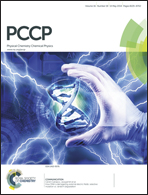O− from amorphous and crystalline CO2 ices
Abstract
O− desorbed from amorphous and crystalline films of CO2 at 18 K under low energy electron impact is studied using time of flight mass spectrometry. The nature of the CO2 film is characterized by Fourier transform infrared spectrometry as a function of film thickness. It is found that the desorption rate from amorphous films is considerably larger than that from crystalline films. The desorption signal from the 4 eV resonance is found to be the dominant one as compared to that from the higher energy resonances, notably the one at 8 eV observed in the gas phase. This is explained in terms of the large enhancement in the dissociative electron attachment cross section for the 4 eV resonance in the condensed phase reported earlier using the charge trapping method.


 Please wait while we load your content...
Please wait while we load your content...